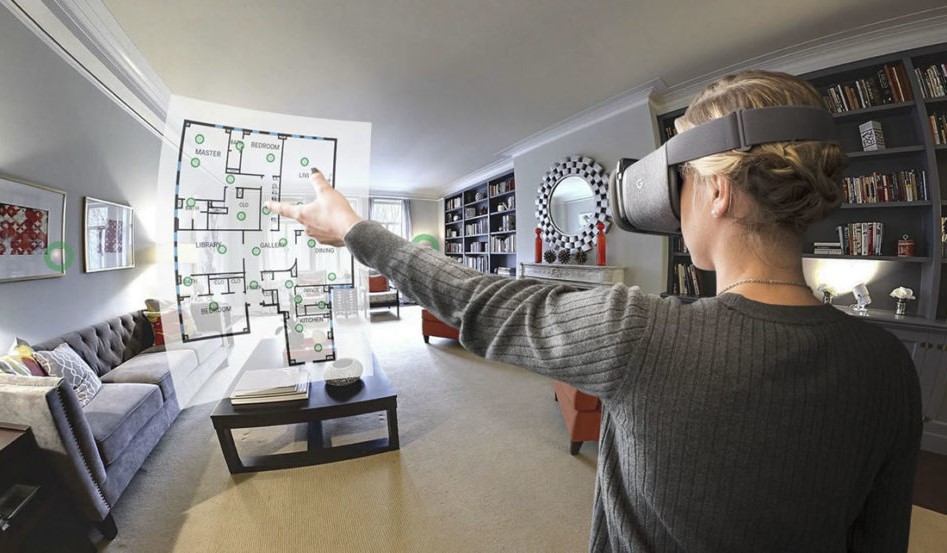Top tech trends that will dominate
real estate market, architecture
& interior design in 2019

What do real estate, interior design, and architecture have in common? The only and the most important thing – they all operate with space.
Right now, the real estate industry is witnessing major changes. The entire approach to architecture & interior design is changing, with the main focus shifted on benefits for people. The intuitive professions of an architect and interior designer are beginning to discover the value of a real-time, actionable feedback loop.
Let’s explore tech trends that will affect these industries and help them evolve in 2019.
VR & AR development
2019 is going to become a decisive year for VR technology. We already see it becoming more accessible and affordable day by day, although it’s still rarely used in some industries.
In real estate, VR apps are changing the way wealthy people buy homes. 77% of US consumers would like to take home tours using virtual reality. Thanks to VR app development companies, modern buyers can view luxury properties that haven’t been completed yet. And then, make buying decisions. Screening through dozens of properties within a few minutes saves clients weeks or even month of work. Soon enough, you won’t even need to leave your house thanks to the best VR apps. Foreign buyers won’t have to travel to another country for viewing the house. You’ll just put on a VR headset and have a virtual tour instead.
A great example of VR apps in 2019 is the VRMello tool. It’s a cloud-based real estate platform for buying & selling houses, in a convenient & non-traditional way. Potential buyers can browse through the property listings, engage with agents and sign the documents from their homes. Making fewer efforts, people can sell their homes to a larger marketplace. The VR app will be launched in winter 2018.
Real estate agents also use augmented reality apps to promote their houses/apartments. Offering clients realistic AR experience instead of showing outdated catalogs & pictures, they achieve a solid competitive advantage over the others:
More architects are starting to use VR development to offer 3D immersive walk-throughs to their clients before & after they are built. In 2019, we will see new & fascinating features enhancing user experience. For example, Twinmotion 2019 has added an interactive menu to their VR mode. Now users can see architectural objects in various weather conditions, during all times of the day or seasons. Architects can also measure distances in their projects, set a precise geographical location and do multiple other things in the VR mode. Thus, VR app development companies are already using the best practices & carefully study clients needs to make the most of VR technology.
The average modern citizen will use the AR app to check if the furniture items fit in his/her apartment & style. This will lead to increased satisfaction rates and more sales.
Architects will use AR development to further visualize the exterior & interior design projects. Specialists will review architect works in full 3D using the AR feature, exploring the plans with clients and making to-the-point discussions. The augmented reality will greatly simplify communication between clients, designers & end-users.
Here’s the example of how AR app is used in architecture & construction:
Overlaying virtual models on construction sites will allow viewing the projects before they are built, thus confirming that all job requirements are met. The augmented reality apps will allow to view the objects in 1*1 life size, providing a more realistic experience. In real estate, this will also largely enhance customers experience, allowing them to walk in and around the future home.
Here’s the example of AR development for on-site usage:
Artificial intelligence software
In 2019, predictive analytics will allow architects to study consumer preferences & behavior specifics to build customer-centric projects. Using machine learning algorithms, designers will be able to find out the most optimal ceiling heights, space modulation and other important factors. As a result, they will make wiser decisions & achieve higher satisfaction rates.
The most common application of AI in architecture which we see now is automating manual drawing & calculating tasks, cutting tons of architects’ time & work.
In 2019, architects will use artificial intelligence to process Big Data, which will result in more informed decisions. For example, a specialized software can help to analyze data about 200 different meeting rooms in various-size companies. Based on this, it will predict how many of them a specific company needs (to avoid creating too many or not enough). Machine-based predictions are 40% more accurate than those made by humans. Artificial intelligence software will help architects to make important decisions without fully replacing humans.
A parametric design (design driven by parameters, that is generated automatically) will become more widespread, applied to smaller & simpler buildings. Together with artificial intelligence, it will record the whole lifecycle of a building, maintenance & replacements that were made. As a result, the machines & architects will learn from mistakes made in the past.
Imagine an architect entering specific dimensions, materials, project type into AI software system, and achieving thousands of possible building versions within minutes. 2019 will be the year when this will become a reality. Architects will use AI software to solve difficult design problems, not just as a visualization tool.
However, AI development has even greater potential in real estate. Combined with big data, artificial intelligence can predict a home value, costs of home improvements based on data accumulated from various sources.Real estate companies will become the one-stop contact points for their clients. So, instead of relying on referrals & searching for legal counsel, clients will use the AI-powered platforms to fix financial, legal, generally all types of issues.
IoT
In 2019, the IoT solutions will grow both in complexity and usage. A tech-oriented design will become more visually appealing and stylish. For example, we can mention smart TV picture frames presenting your favourite works of art while turned off. Also, imagine a table with an integrated sound speaker that automatically cleans itself and looks stunning.
Generative design
Designers will benefit from design driven by machine learning software. This is how it works: a designer enters specific design constraints into software, including materials, dimensions, client requirements. Within seconds, the system produces thousands of possible design versions for a designer to further work on them. As a result, one can increase the working efficiency, cutting the amount of time & costs needed.
All in all, 2019 is going to be a promising year for design, architecture & real estate sectors. 3D interior software or any other kind of software is not going to replace interior designers, not yet. Instead, designers, realtors and engineers will use innovative technologies to enhance & simplify their work. For this, they will need to turn to top IoT companies providing them customized software solutions. So, are you ready to experience the future?




